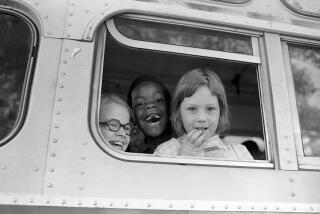In Matters of Race, Teach by Example
After her first day of preschool, a 4-year-old white girl comes home and tells her mother there’s a “little maid” in her class.
An African American teen says his black friends ostracize him because he “dresses white.”
After a generation of “Sesame Street,” multicultural classrooms and multicultural Barbies, parents are frustrated when they see racism is not only alive and well but sometimes thriving--in their own children. What more, they ask, can they do?
About 40 things, starting with admitting their own failings and working to improve their own interracial relationships, according to Washington Post journalists Barbara Mathias and Mary Ann French, authors of “Forty Ways to Raise a Nonracist Child” (HarperCollins, 1996).
French, who is African American and the mother of a 6-year-old boy, and Mathias, white and the mother of grown children, interviewed experts and parents and searched their own souls to come up with the list. Some of the ideas are standard and common-sensical (examples speak louder than lectures). Some are new and challenging (if you don’t have friends of another race, at least choose professionals of differing races).
All are worth considering, especially when, as the authors had found, hardly any of the parenting books that crowd bookstore shelves today address the crucial question of developing racial skills.
Racism is so widespread and serious that it must be faced head-on without pretense of colorblindness. “When you say, ‘I don’t care about color, if you’re black, white, blue, green or orange,’ young children take that literally. They know people don’t come in colors of crayons. They are going to interpret your message as trivial,” French said during a recent visit to Los Angeles. Instead, parents must teach respect in developmentally appropriate ways from infancy to adolescence.
Babies begin noticing racial differences at about 18 months. It is then that white parents should seek racially balanced day care or preschools and minority parents should seek schools where their children are not the lone “ambassadors of multiculturalism,” the authors say.
In early elementary school, playground politics make it clear that skin colors are codes, denoting rank and even fate. At this age, parents can provide a multicultural education and environment through books and inviting children of other races over to play.
As they enter adolescence, the need to belong to a group grows and peers can overpower parents in influence. At this age, parents can listen and try not to overreact to stories of overt racism. At the same time, they need to communicate with one another and school authorities to defuse any racial tensions they sense.
Self-segregation remains a persistent fact of life through high school, college and beyond. For adults, developing interracial skills is a matter of courage, practice and bruised egos, as French and Mathias found out.
“We just tried to set up tools that parents could use any day that would constitute a small step toward a saner world,” French said. “There are no miracles in this business.”
* Lynn Smith’s column appears on Wednesdays. Readers may write to her at the Los Angeles Times, Life & Style, Times Mirror Square, Los Angeles, CA 90053, or via e-mail at lynn.smith@latimes.com. Please include a telephone number.
More to Read
Sign up for our Book Club newsletter
Get the latest news, events and more from the Los Angeles Times Book Club, and help us get L.A. reading and talking.
You may occasionally receive promotional content from the Los Angeles Times.







